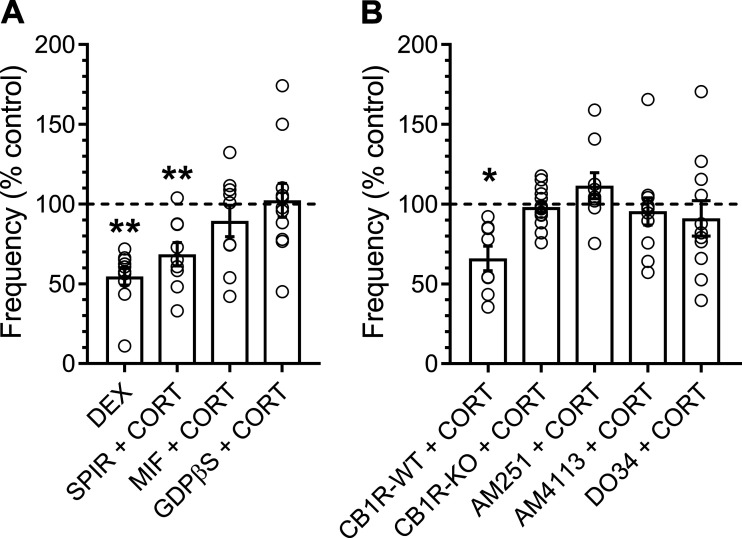Fig. 4.
Postsynaptic glucocorticoid and presynaptic cannabinoid-type 1 (CB1) receptors are required for the effects of corticosterone (CORT) on spontaneous excitatory postsynaptic currents (sEPSC) frequency. Plots show means ± SE change in sEPSC frequency in the presence of various agonists and antagonists. A: bath application of dexamethasone (DEX; 1 µM) inhibited sEPSC frequency similar to CORT (n = 10 neurons / 3 mice; P = 0.001, paired t test). The mineralocorticoid receptor antagonist spironolactone (SPIR; 300 nM) failed to block the inhibitory effects of CORT (n = 9 neurons / 4 mice; P = 0.006, paired t test), while the glucocorticoid receptor antagonist mifepristone (MIF; 10 µM) blocked the decrease in sEPSC frequency (n = 9 neurons / 5 mice; P = 0.26, paired t test). Intracellular application of the G protein inhibitor GDPβS (500 µM) also blocked the effects on spontaneous release (n = 10 neurons / 3 mice; P = 0.63, Wilcoxon test). B: CB1R-wild-type (WT) mice exhibited a decrease in sEPSC frequency to CORT exposure (n = 9 neurons / 3 mice; P = 0.017, paired t test), while genetic deletion of the CB1 receptor (CB1R-KO) prevented CORT-induced decrease in sEPSC frequency (n = 13 neurons / 4 mice; P = 0.09, paired t test). Both CB1 receptor antagonists AM251 (n = 9 neurons / 4 mice; P = 0.13, Wilcoxon test) and AM4113 (n = 11 neurons / 3 mice; P = 0.37, Wilcoxon test) blocked the effects of CORT on frequency. Intracellular application of the DAG lipase inhibitor DO34 (10 μM) also prevented the effects of CORT on sEPSC frequency (n = 11 neurons / 6 mice; P = 0.12, using paired t test). *P < 0.05, **P < 0.01.

